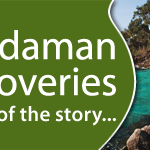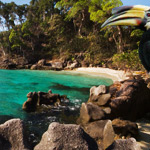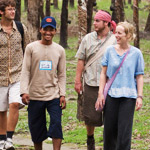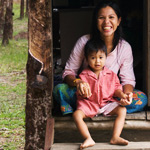Andaman Discoveries Blog
Thursday, July 16, 2009
Lucky To Have You
Teacher Karen Honored in Wai Khru Ceremony
 I was asked if I would like to attend a Wai Khru ceremony to honor and respect the teachers. Of course I jumped at the chance to take part in a local, traditional celebration.
I was asked if I would like to attend a Wai Khru ceremony to honor and respect the teachers. Of course I jumped at the chance to take part in a local, traditional celebration.Participating in the Wai Khru ceremony was a humbling experience. I’ve volunteered as a part-time English teacher in Kuraburi and at the Burmese Learning Center since September 2008. To be a part of this ceremony was a true honor.
The main sports hall was filled with students from Kuraburi Chai Pattana Pittiya Kom. All the teachers sat at one side of the hall.
Buddhist Monks led chanting and prayers for the first hour. Once the monks had been presented with food and gifts, the chairs were moved to the main stage. I was invited to take a seat on the main stage. “Are you sure? I only teach one day per week.” I said.
“Yes, we are honored and lucky to have you – you are part of our teachers!” a staff member replied. The director and assistants sat on comfortable leather seats at the front of the stage. Elaborate flower decorations were presented to them. The children walked to the stage, but once on the stage, they made their way to the director by walking on their knees to display the utmost respect.
The children gave a “wai” to the director and assistants. They bow three times. The first bow is toward the floor. They then offer the flower arrangement to the directors and assistant on the second bow. The director touches the head of the student and offers words of encouragement. It is all moving, especially knowing how sacred the head is in Thai culture. The tenderness in how the ceremony is carried out is touching.
The rest of the children made their way to the stage and started to present the remaining teachers with flowers in various shapes and sizes. One of the main flowers was the Champa, a heavily scented flower that signifies the passing of knowledge.
Again, the children shuffled on their knees in front of each teacher, presented the flowers, and bowed to the floor on their knees showing respect. I felt inadequate in giving out words of wisdom. Would they be disappointed at being placed before the farang teacher? Well, if they were, no one showed it.
I felt comfortable after the first group of students had left the stage. Once relaxed, I took the respect in stride. The ceremony lasted all morning. It included dancing, singing and judging of the beautifully-carved, carefully thought-out flower arrangements.
I felt tremendous joy and emotion at being included in such an event. The willingness for Thai people to include others in events, their strong ties to traditions that show respect and honor to peers, is something that astounds me. This sincere respect for teachers is something that we in the west seem to have lost, and such a pity we have.
To learn more about Karen, read her bio on the AD staff page.
The BBC is coming!
AD Short listed for Award
 The work of Andaman Discoveries is not only helping to change lives at a grassroots level, but are also changing approaches to business development. So concluded the judges at the World Challenge 2009 -- a global competition aimed at finding projects or small businesses from around the world that have shown enterprise and innovation at a grass roots level -- who recently named Andaman Discoveries one of the twelve finalists for this prestigious award.
The work of Andaman Discoveries is not only helping to change lives at a grassroots level, but are also changing approaches to business development. So concluded the judges at the World Challenge 2009 -- a global competition aimed at finding projects or small businesses from around the world that have shown enterprise and innovation at a grass roots level -- who recently named Andaman Discoveries one of the twelve finalists for this prestigious award.As a finalist, we will be featured by the British Broadcasting Corp. (BBC). The filming is scheduled for early July, and will include footage from village activities as well as long-term volunteering. The voting period is from September 28 through November 13. Please check future newsletters or contact us for updates on when our segment will air and for voting information.
Thank you to Stanislava Cholakova, on behalf of the SEED Initiative, for the nomination.
The support of SEED has been influential in this recognition. Being a finalist in the World Challenge increases AD’s ability to garner support for our projects and further benefit the communities of the North Andaman Region.
Labels: BBC, enterprise, grassroots level innovation, World Challenge 2009
Sage Wisdom
Bill Tuffin consults with Andaman Discoveries
 Andaman Discoveries sends a big thanks to Bill Tuffin, who joined us as a consultant for two weeks. Bill first arrived in the Southeast Asia as a United States Peace Corps volunteer in the mid-1980s, and quickly developed a passion for Southeast Asia. Subsequently, Bill was the innovator behind the first eco-lodge is Laos, and made been deeply involved in responsible tourism development. “When I first saw Andaman Discoveries online, I followed its development with interest and wanted to learn more about the AD’s work in the North Andaman Region. I finally got a chance to work with the team this past month,” said Bill.
Andaman Discoveries sends a big thanks to Bill Tuffin, who joined us as a consultant for two weeks. Bill first arrived in the Southeast Asia as a United States Peace Corps volunteer in the mid-1980s, and quickly developed a passion for Southeast Asia. Subsequently, Bill was the innovator behind the first eco-lodge is Laos, and made been deeply involved in responsible tourism development. “When I first saw Andaman Discoveries online, I followed its development with interest and wanted to learn more about the AD’s work in the North Andaman Region. I finally got a chance to work with the team this past month,” said Bill.Bill shared his extensive experience with us during his two-week visit. In addition to expertly facilitating our staff retreat, he offered his thoughts and feedback on everything from our business model to our promotional materials. “It was a pleasure to work with the AD team. They are highly motivated and dedicated to the work that they are doing.”
Bill has been a consultant for the recognized Ecotourism Laos website and was instrumental to the success of the Akha Experience and Green Discovery Laos. For more information about Bill, or to contact him directly, please visit his website.
Thank you for joining us Bill! We hope to see you again soon.
Labels: Akha Experience, Bill Tuffin, ecotourism consultant, Ecotourism Laos, Green Discovery Laos
Lesson Plans
 Burmese Learning Center Welcomes Teachers
Burmese Learning Center Welcomes Teachers According to Thai law, all children, regardless of their status in the country, are entitled to receive an education. Children of migrant Burmese workers, however, face overwhelming challenges, including communication issues, the lack of resources for them at schools, and prohibitive expenses for supplies and uniforms. For these children, The Kuraburi Burmese Learning Center and volunteers like Rebecca Lilly (UK) are critical to a hopeful future.
“In the brief month that I taught at the Burmese Learning Center, I felt that I developed relationships with the students and teachers. The students’ confidence and skills grew steadily, as did mine, as I learned to find my footing as a teacher in Thailand,” said Rebecca, who volunteered from mid-May to mid-June. Rebecca chronicled her experiences as a first-time teacher, as well as adjusting to life in rural Thailand with a surprise reptilian roommate.
Teaching at the Burmese Learning Center is one of several long-term volunteering programs offered by Andaman Discoveries. We can also arrange placements at the Phuket Disabled School or a Southern Thailand Orphanage. For more on Rebecca’s experience, check out her recent blog posts.
Labels: Burmese Learning Center, education, migrant workers
Freshman Year
Villagers Experience First-Hand Training
 The village of Ban Lion on Koh Phratong became a real-life classroom for two days in June. Built after the tsunami, Ban Lion is a collective of people from many different villages and cultures, yet they live together harmoniously.
The village of Ban Lion on Koh Phratong became a real-life classroom for two days in June. Built after the tsunami, Ban Lion is a collective of people from many different villages and cultures, yet they live together harmoniously.We held a training and pilot tour on how to manage and develop activities for tourists, with help from the Mangrove Action Project. The villagers’ enthusiasm was encouraging...
“A place is about the people. The people of the Ban Lion Village made the experience. The guides and homestay hosts exuded an enthusiasm that cannot be imitated. Their pride and willingness to share their way of life was remarkable,” said Program Development Manager Mimi Cheung.
Ban Lion is surrounded by a fertile mangrove forest and swamp forest, and the villagers take pride in the biodiversity in and around their village. There are marine animals such as sea turtles, dugong, and dolphins. Bird watchers rejoice at the abundant avian offerings, including the rare lessor adjutant stork.
Ban Lion Village was built with the support of Lions Club International for tsunami-affected people from several villages on Koh Prathong, including Pak Jok Village, which was totally destroyed. The ultimate goal of the training is to promote development of community-based tourism. “By sharing their lifestyle and the jewel of Koh Phratong, the villagers pride increases as well as their motivation to preserve the place they call home,” said team member Leslie Welshimer.
Koh Phratong’s stunning environment has made it a focus of conservation groups like Naucrates and Mangrove Action Project (MAP). Andaman Discoveries, North Andaman Community Tourism Network (N-ACT) and MAP (Mangrove Action Project) collaborated to offer the training for Ban Lion village in June (with funding support provided by the Ecumenical Coalition on Tourism).
Jeannine Curd, volunteer English teacher and pilot tour participant, said, “I feel honored to have been a part of the first group to come to this village on a CBT program. The people were all very helpful.”
Jaruwan Kaewmahanin (Ning), Thailand Field Project Manager for MAP, said, “Ban Lion is unique because it is a collective of people from many different villages and cultures, yet they can live in a harmonious way.”
Read Leslie Welshimer’s pilot-tour participant story.
Labels: Ban Lion, biodiversity, community tourism, Koh Phratong, Mangrove Action Project, Pak Jok Village
Graduate School
Ban Talae Nok Shares Lessons Learned
 Not long ago, several villagers from Ban Talae Nok were learning how to implement a successful responsible tourism and youth conservation program in their village. Today, the award-winning Ban Talae Nok CBT program is the aspiration of many organizations in the region, including twelve villagers from Cambodia who, with support form IUCN and WWF, hope to replicate BTN’s success. “I am so glad to see another homestay come from another country to learn in my village. I hope they enjoyed and learned a lot.” said a beaming Ladda “Pink” Aharn.
Not long ago, several villagers from Ban Talae Nok were learning how to implement a successful responsible tourism and youth conservation program in their village. Today, the award-winning Ban Talae Nok CBT program is the aspiration of many organizations in the region, including twelve villagers from Cambodia who, with support form IUCN and WWF, hope to replicate BTN’s success. “I am so glad to see another homestay come from another country to learn in my village. I hope they enjoyed and learned a lot.” said a beaming Ladda “Pink” Aharn.The CBT graduates in Ban Talae Nok were also busy hosting the Tourism and Sports Authority of Thailand, who came to measure their compliance with the homestay standard; the village expects to receive certification soon.
Recycling has been the focus of the Youth Group, who, with funding from the EU, received training on how to make cards from recycled paper. The youth group also provided new recycle bin for the every house in the village.
Labels: Ban Talae Nok, Cambodia, responsible tourism, Tourism and Sports Authority of Thailand, youth conservation
There is no “I” in Team
N-ACT Group Management Training
 Nineteen people from six area villages took part in a group management training to help define current status of tourism in their village and learn how to work in a team. Expert facilitation was provided by Mangrove Action Project, with support from the Ecumenical Coalition on Tourism.
Nineteen people from six area villages took part in a group management training to help define current status of tourism in their village and learn how to work in a team. Expert facilitation was provided by Mangrove Action Project, with support from the Ecumenical Coalition on Tourism.Villagers from the North Andaman Region came together for three days in June with one common goal: to learn how to most effectively manage their CBT programs. The first day of the training allowed for everyone to get to know each other, understand each other’s communities and individual CBT programs. The villagers who participated in the training at Kuraburi Resort are from Tung Dap, Ban Talae Nok, Ton Kloy, Ban Na, Ban Lion, and Had Phrapat.
Bodhi Garrett, founder of N-ACT and Andaman Discoveries, kicked off the meeting by stating, “Think of your CBT -- where it is now and where you want it to go.” Participants learned how to work in a team and manage meetings. Nattaya “Nat” Sektheera, N-ACT program manager, said, “Villagers departed the training, confident, with new knowledge and an understanding of how to manage a meeting within their CBT programs.”
Labels: CBT, Mangrove Action Project, North Andaman Region
Take a Hike ... Up Mae Nang Khaow Mountain!
N-ACT Organizes Pilot Trip
 The North Andaman Community Tourism (N-ACT) Network arranged a light trek up Mae Nang Khaow Mountain with ecotourism specialist Bill Tuffin. The purpose was to determine the viability of the hike as an ecotourism activity for Mae Nang Khaow village. “The route was of high interest, with fascinating things like a large banyan tree. The hike has potential for a tourist activity once the route is improved,” concluded Bill.
The North Andaman Community Tourism (N-ACT) Network arranged a light trek up Mae Nang Khaow Mountain with ecotourism specialist Bill Tuffin. The purpose was to determine the viability of the hike as an ecotourism activity for Mae Nang Khaow village. “The route was of high interest, with fascinating things like a large banyan tree. The hike has potential for a tourist activity once the route is improved,” concluded Bill.The hikers were treated to a peaceful waterfall during the three-hour activity, which bypassed the summit in favor including a local temple. (Venturing further up the mountain could reward more intrepid trekkers with additional waterfalls and a possible sighting of the famous raffleasia flower.)
N-ACT strives to support villagers in the region through activities like the Mae Nang Khaow hike. “The villagers are keen to welcome guests. Pilot tours help us determine areas for potential and for improvement, like points in the hike to explain interesting plants or history. One such point of interest is a big Sai and stone at the ground,” said program manager Nattaya “Nat” Sektheera.
Labels: community tourism, ecotourism, N-ACT, raffleasia flower, trekking
Call for Support
More than one million displaced by Cyclone Aila
 More than 100 people were killed and at least a million were displaced when Cyclone Aila, driven by winds in excess of 60 miles per hour, slammed into Bangladesh and eastern India on May 25. Our friend Trine Willumsen of Grace Tours contacted Andaman Discoveries with the request to help spread awareness of this natural disaster. To learn more about the disaster or how you can help, please visit the group page to support the victims of Cyclone Aila, initiated by The Blue Yonder, Traveltocare.com, and Help Tourism. You can also click on ReliefWeb and AlertNet for updates on the aftermath of the storm.
More than 100 people were killed and at least a million were displaced when Cyclone Aila, driven by winds in excess of 60 miles per hour, slammed into Bangladesh and eastern India on May 25. Our friend Trine Willumsen of Grace Tours contacted Andaman Discoveries with the request to help spread awareness of this natural disaster. To learn more about the disaster or how you can help, please visit the group page to support the victims of Cyclone Aila, initiated by The Blue Yonder, Traveltocare.com, and Help Tourism. You can also click on ReliefWeb and AlertNet for updates on the aftermath of the storm.Labels: Bangladesh, Cyclone Aila, Grace Tours, India, The Blue Yonder
Monday, July 13, 2009
Learning about Elephants
 Experiences in Thailand
Experiences in ThailandBy Leslie Welshimer
Eager visitors flock to Thailand to experience the country’s welcoming people, stunning scenery, appetizing cuisine and the chance to get up close with an elephant (Chang in Thai).
In choosing where to spend time with elephants, it was important to me to choose an organization that was ethical and truly helping elephants. I’d read rave reviews about the Elephant Nature Park near Chiang Mai, so after some investigation, I booked the “Learning Elephant” day tour.
The Elephant Nature Park is a sanctuary and rescue centre for about 30 elephants. It’s located in a breathtaking valley. The park is bordered by a river and encircled by forested mountains in Chiang Mai province.

Being in the presence of elephants was humbling and mesmerizing. We were given a sizable bucket full of bananas, corn and squash to feed one elephant. The elephant looked at us with kind eyes and gently took food from our hands.
After feeding, we had some downtime to relax and watch the elephants stroll about the park. I would have been happy to just sit and watch them for hours. The interaction in activities, like feeding and bathing, was just icing on the cake.
The bathing was one of our favorite parts, as we had the opportunity to wade in the water and immerse with the elephants. Buckets and brushes were distributed to volunteers and guests to split the duties.
The lunch that we were provided was astounding. It was a full buffet of 20+ options. The feast would leave even the most selective eater with a beaming smile and full belly.
The afternoon brought a second round of feeding and bathing for the elephants and more enjoyment watching the elephants roam in the peaceful solitude of the park.
There was an educational element woven throughout the day’s events, including about an hour where we watched a documentary about Asian elephants. The documentary was powerful, eye opening and inspired us to want to help.
The memorable day concluded with transport back to our guesthouse. Our exceptional guide, Chet, gave us a chat about how people can make a difference and concluded by saying, “Take care of your health and your love. Make the world smile.”
If you’re interested in visiting the Elephant Nature Park, click here to learn more.
Labels: Elephants, Thai culture, Thailand
Saturday, July 11, 2009
Class Act
Thank You Leslie!
 The month of June ended on a bittersweet note as we celebrated our all-too-brief time with Leslie Welshimer. Leslie joined Andaman Discoveries in late January, and though she was hired as an “intern,” the title feels wholly unworthy of the mark she forever left on the organization. Leslie dove headlong into the chaos on day one without complaint, and she found her footing almost immediately. She could always be counted on for her cheerful smile (even after the fourth power outage of the day), unwavering commitment to getting the job done, and for being the first person to volunteer to take on a new challenge. In just over five months Leslie accomplished a staggering amount of crucial work for us.
The month of June ended on a bittersweet note as we celebrated our all-too-brief time with Leslie Welshimer. Leslie joined Andaman Discoveries in late January, and though she was hired as an “intern,” the title feels wholly unworthy of the mark she forever left on the organization. Leslie dove headlong into the chaos on day one without complaint, and she found her footing almost immediately. She could always be counted on for her cheerful smile (even after the fourth power outage of the day), unwavering commitment to getting the job done, and for being the first person to volunteer to take on a new challenge. In just over five months Leslie accomplished a staggering amount of crucial work for us.She came to Andaman Discoveries to combine her passions of travel, nature, and outdoor recreation with her background in communications and marketing. We have her tireless efforts to thank for completing several important award applications (and any fruits they may bear); she wrote copy for several new pages on the website; dusted the cobwebs off the Andaman Discoveries blog and filled it with lively stories of her experiences at Andaman Discoveries and of her travels in Thailand, creating a resource that will resonate for years to come; she helped settle and reassure new volunteers; managed to visit all of the communities and volunteer projects we serve; and you have her to thank for the bulk of this and the past several newsletters.
That list really just scratches the surface. Just as importantly, she truly loved the culture of Thailand and its people, and her desire to learn the language and make new friends never waned.
Leslie is now enjoying some domestic travel to see where her parents lived in Northeast Thailand more than 30 years ago. After that, she returns to Seattle, where she has agreed to continue to support Andaman Discoveries with media and university pitches … at least until she finds a full-time job, which, we suspect, may not take her very long. We wish Leslie the very best, and look forward to seeing her in Kuraburi again soon!
Labels: extraordinaire, Leslie Welshimer, marketing, writing
Thursday, July 9, 2009
Rebecca’s Journal – Life at the Burmese Learning Center
 |
| Volunteer English teachers, Jeannine and Rebecca, prepare for an afternoon of classes at the Burmese Learning Center. |
The last week of school came too quickly. In the brief month that I taught at the Burmese Learning Center, I felt that I developed relationships with the students and teachers. The students’ confidence and skills grew steadily, as did mine, as I learned to find my footing as a teacher in Thailand.
It was motivating to learn that I could lead classes, despite being without a formal teaching background. The month at the Burmese Learning Center allowed me to discover an artist and teacher within me.
I was instantly made welcome by the Burmese Learning Center staff. The staff supported me, so that there was always someone there if I was to encounter any problems. The children are lovely, full of personality and a pleasure to teach. There is a great atmosphere at the center.
To anyone considering taking the leap to teach in Thailand through Andaman Discoveries - I have one word – Jump!
Labels: Burmese Learning Center, education, teaching english, volunteer
Monday, July 6, 2009
Rebecca’s Journal – First Day of School
I was filled with apprehension, clutching my lesson plans, as I awaited the start of my first day teaching.
The first class of the day was grade one. The class exuded enthusiasm, cheering, “Teacher, teacher, teacher!”
 |
| Rebecca takes in the scene near the Burmese Learning Center. |
Just as I began to feel panic, Sawsaw (one of the Burmese teachers) calmed the class down. The lesson ran surprisingly smooth. Drawing and singing proved to be keys to the students’ attention. I’m far from being in the category of the likes of Claude Monet or Vincent Van Gogh, but I decided I’d better develop my artistic side quickly to excel at this new role.
The rest of the first day was nerve racking, but an overall success. I introduced myself to the children. After their initial shyness dissipated (excluding grade one, who were certainly not shy), I felt the students responded well. I anticipated the next few weeks, excited to see just how far the students and I would grow. Monet just may have competition yet!
Labels: education, teaching english, volunteer
Friday, July 3, 2009
Erik's Adventures - Mangrove Planting in Tung Dap
 From Tung La Ong pier, the departure point from the mainland, the light of dawn shimmered off the dense mist draped over the distant mountains, coating the rainforest with what looked like a rippled layer of icing. Two festively-painted fishing boats idled nearby while women perfunctorily sorted the previous night’s catch. Here I met Nu, my boat driver, a quiet but amiable young man with a shock of jet-black hair that he wears in the rough-cut mullet style currently in vogue in Thai pop culture. With a vigorous crank, our traditional longtail’s engine came to life in a piercing fit, and soon Nu was expertly ferrying us over the tranquil waters of the Andaman Sea towards the southwestern tip of Koh Phratong, home of the fishing village of Tung Dap.
From Tung La Ong pier, the departure point from the mainland, the light of dawn shimmered off the dense mist draped over the distant mountains, coating the rainforest with what looked like a rippled layer of icing. Two festively-painted fishing boats idled nearby while women perfunctorily sorted the previous night’s catch. Here I met Nu, my boat driver, a quiet but amiable young man with a shock of jet-black hair that he wears in the rough-cut mullet style currently in vogue in Thai pop culture. With a vigorous crank, our traditional longtail’s engine came to life in a piercing fit, and soon Nu was expertly ferrying us over the tranquil waters of the Andaman Sea towards the southwestern tip of Koh Phratong, home of the fishing village of Tung Dap.Tung Dap was almost wholly leveled by the tsunami of December 2004, and particularly hard hit were its mangrove swamps. Although the village has since been rebuilt and life has largely returned to normal there, the work of restoring the mangroves, a vital coastal buffer and ecosystem, continues.
We moored the boat just offshore and set upon our first task: retrieving several canvas sacks of mangrove seedlings. With the help of Nu I’d soon added useful new lexis to my budding Thai language skills: nok maak, which means very heavy! Indeed, gravity seemed to increase by an order of magnitude as we plodded through the fine, sediment-rich mud, and before it occurred to me to remove them, the sucking vacuum of each footstep simultaneously claimed both of my 35-Baht flip-flops.
 From there Nu piloted the boat to Tung Dap pier, where we were joined by his wife Pin, as well as Yui and Fen, who’d prepared a savory breakfast of squid in chili sauce, pickled eggs, and fresh vegetables accompanied by white rice -- the foundation of any Thai meal.
From there Nu piloted the boat to Tung Dap pier, where we were joined by his wife Pin, as well as Yui and Fen, who’d prepared a savory breakfast of squid in chili sauce, pickled eggs, and fresh vegetables accompanied by white rice -- the foundation of any Thai meal.With our team now assembled and sated, we leisurely reboarded the longtail and headed inland, navigating our way along a meandering river channel. More than two years after the tsunami, the evidence of destruction is still readily apparent here, with large swaths of denuded land still bearing testament to the wave’s destructive power.
Mangrove seedlings look a bit like unburned candles, varying in length from a few inches to over a foot, and ranging in hues of green similar to those of an avocado. These remarkable seedlings are germinated while still attached to the parent tree, and can produce their own food via photosynthesis. A mangrove seedling often travels great distances by water, and can actually alter its own density depending on whether it needs to float or upright itself to take root. Furthermore, it can survive desiccation and remain dormant for over a year until it arrives at a suitable environment in which to find purchase.
 Using my t-shirt as a basket, I loaded up several handfuls of seedlings and schlepped along the mucky shore. My instructions were simple: lodge each seedling about an inch or two into the ground, and make sure to space them a few feet apart; any seedlings that were missing a “wick” were no good.
Using my t-shirt as a basket, I loaded up several handfuls of seedlings and schlepped along the mucky shore. My instructions were simple: lodge each seedling about an inch or two into the ground, and make sure to space them a few feet apart; any seedlings that were missing a “wick” were no good.In bare feet, I constantly fought to mask the discomfort of traversing the prickly stubble of protruding sticks; I was already failing to keep pace the locals, with their obviously thicker-skinned soles. Three hours and a few scrapes and cuts later, we’d filled vast barren stretches of shoreline with seedlings, greatly facilitating the restoration of the coastal environment.
We then headed to a nearby beach where, with empty canvas sacks in hand, we embarked on our final mission for the day, which was to collect more seedlings. I’d previously assumed the seedlings were farmed or brought in from somewhere (as they are in all other mangrove reforestation programs in the Koh Phratong area), but it turns out they wash up in abundance along the beach -- in an hour we’d filled five sacks of them, which we left on the beach for tomorrow’s crew. I also found two mismatched but functional flip-flops amongst the flotsam and jetsam, greatly easing my trip back to Kuraburi.
Back at sea, Nu stopped the boat and Fen instructed me in English that “now we go swimming.” We playfully splashed around in the Andaman’s saline waters, liberating ourselves of mangrove mud and allowing the morning’s toil to slip away. The resilience of Tung Dap’s people struck me at this moment: from day one they’ve been steadfast in their determination to restore their lives and their village, and in a manner that’s respectful of the natural environment. Innocent laughter reverberated as we took turns hoisting one another into the water. Remarkably, in the face of everything it’s taken from them, the people of Tung Dap are at completely peace with the sea.
Labels: activities, ecotourism, habitat restoration, Hands-on, mangrove planting, tsunami, Tung Dap
Rebecca’s Journal – Life in Kuraburi
When I first saw Kuraburi, I wondered, where the rest of it was. “Is this it?” I asked. It took me a few days to adjust to a life that vastly contrasts from my home in England.
Eventually, I found that while the town is small, it had more than its fair share of attractions to keep me entertained. It has a lovely atmosphere and buzz about it that I hadn’t experienced anywhere before.
Spending one month in Kuraburi gave me an insight into Thai life. I never would have experienced this viewpoint had I only visited the tourist hotspots of Thailand.
 |
| Kelly, Karen and Rebecca relish the sunset at Ao Khoei beach near Kuraburi. |
Kuraburi gave me the chance to visit the morning and night markets, eat an abundance of traditional Thai dishes and taste exotic fruits that I didn’t know existed.
Community aerobics was one of my favorite activities. Dancing, sweating and enjoying music with local Thai woman was the ideal conclusion to a day of teaching. The classes are held Monday to Friday at about 5:15 p.m.
The month in Kuraburi was thoroughly enjoyable. I’m glad that my travels began in Kuraburi with Andaman Discoveries and of course, Gary the Gecko.
Labels: Kuraburi, Thai culture
Wednesday, July 1, 2009
Community-Based Tourism Pilot Tour: The Real Value of a Home
It’s hard to explain what makes a home inviting and exude warmth. Is it the comfy sofa, the pictures on the wall, or a manicured lawn?
I believe that people create the feel of a place (okay, so architecture is a big player too, but if you fill the most beautiful building in the world with grumps, it’s not going to be a fun place).
Have you ever walked into a work place, and felt tension so thick, you could cut it with a knife? No one is talking, but yet you feel the emotion of the people.
| Ban Lion Village |
Ban Lion showed me what makes a place. The people, with genuine warmth in their eyes, a smile and the kindness to share their lives made their residences inviting, not the homes lined up like an Excel spreadsheet.
Our destination for a two-day pilot tour in June was Ban Lion, a village located on the northwest side of Koh Prathong in Phang Nga Province. The residents are a collective of people from different villages who were affected by the tsunami in 2004. The homes in the village were built with the support of Lions Club International.
We were greeted while unloading from the boat. I was instantly impressed that the villagers came to us, versus waiting for us to come to them.
The home style in Ban Lion likely contrasts the image of Thai homes most foreigners have in their heads. My first thought upon arrival was, “Am I in an American suburb?” Completely identical homes are in clean, distinct lines.
Any confusion I had was replaced and trumped ten-fold by the people. They were so determined to make us feel at home. Our homestay hosts were two, 20-year-old girls, who work at the nearby Golden Buddha Beach Resort.
The first day we explored sea grass at low tide where pools were full of more star fish than I’d ever seen at once. We visited the old village, called Pak Jok. The tsunami devastated Pak Jok Village, leaving only small sections of concrete road and the bases of a few buildings. From there, we walked to the beach for sunset.
| Sun Dew Plant |
On day two, we took a short tractor ride to the golden grass fields. Our energetic guides’ passion for the area was contagious. They took special care to point out each detail. My favorite plant was the sun dew, which has a trap for insects to fall into to provide the plant with nutrients.
There was a brief discussion at the end of the tour where we gave our feedback on everything from the food to activities. My overall feedback was that it’s the seemingly small stuff that makes a tour, a restaurant, a hotel or the world work. Life is all about the difference between someone pointing down the street, when you’re new in town and ask where post office is, versus someone walking you there and buying you a cup of coffee.
-Leslie Welshimer
Labels: community tourism, homestay, Thai culture, Thailand, Thailand homestay
Subscribe to Posts [Atom]







